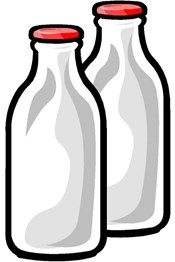Almost all of the milk produced in the United States meets fluid grade milk standards (Grade A in most States). However, only about one-third of the milk is actually processed into fluid milk and cream products.
Fluid milk processors face a unique supply-demand situation not shared by most other food products. Farm milk production varies by day, week, and season because of weather and feed conditions. Similarly, fluid milk sales vary greatly by day and season because of consumer shopping patterns. Because these patterns cannot be precisely predicted, a system must be maintained to get milk where it is needed when it is needed. Shipping milk among locations and storing it for a day or 2 can solve some of the problem, but a pool of "on call" raw milk is ultimately needed. The portion of this reserve not actually used in fluid milk products is manufactured into other dairy products.
Coordinating supply and demand for the fluid market is called balancing. Individual plants may do the balancing, but it is more efficient for a few entities, or even a single entity, to provide the services for a market. Dairy cooperatives have in most cases taken on this important function.
The remaining milk—almost two-thirds of the milk supply—is used to produce a wide array of manufactured dairy products. Almost half of the milk supply is used to turn out about 9 billion pounds of cheese each year. Mozzarella has recently moved past Cheddar to become the most popular variety. Output of most varieties has grown steadily for many years, as cheese has become a staple in the American diet.
Production of ice cream and other frozen dairy products totals about 1.5 billion gallons, about two-thirds of which is regular ice cream. Frozen dairy products are commonly made by fluid milk processors, although specialized plants are well established.
Butter and nonfat dry milk traditionally were joint products. The cream from milk was churned for butter, and the remaining skim milk was dried for nonfat dry milk. About a tenth of the milk supply is still used this way, although more than half of the butter produced now comes from cream not needed when milk is used for fluid milk products or cheese. Production of these products has been roughly constant for many years, although their relative share of dairy product output has declined.
The plants that process and manufacture milk into fluid and manufactured dairy products may be proprietary (held by private or publicly traded companies) or cooperatively owned. An example of a proprietary company is Leprino, the largest global producer of Mozzarella cheese. Cooperatives generally produce cheese, butter, nonfat dry milk, and similar manufactured products, but some cooperatives, such as Prairie Farms, Inc., process fluid milk. There is a relatively significant presence of foreign-owned companies in parts of the U.S. dairy industry.




